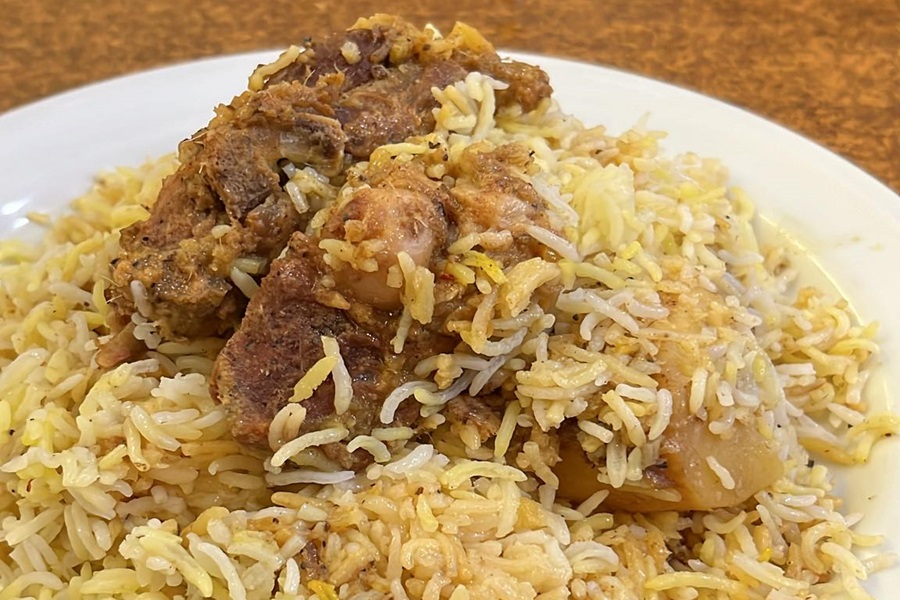
Published :
Updated :

Kacchi is an emotion for Bangladeshi people; it's another name for love. A fragrant and meaty, Kacchi biriyani is cooked with rice, various spices, and marinated raw meat. Bangladeshis have a particular place in their hearts for this gastronomic delicacy. This beloved meal is more than just food; it's a sign of celebration, a tradition, and a reminder of Bangladesh's rich history. However, as Dhaka's kacchi scene develops, various restaurants offer kacchi that vary in taste, flavour, and cooking style.

Crafting a perfect plate of Kacchi
The history of kimchi dates back to the Mughal family. It changed and modified as time passed to suit regional ingredients and preferences. Due to its unique cooking technique, kacchi became an integral dish at weddings and festivities in Dhaka.
'Kacchi' originated from the word 'Kacha', which means uncooked. It is perfectly slow-cooked with layers of partially cooked rice, shallow-fried potatoes, and marinated raw mutton in a sealed pot.
It is made into the 'Dhakaiya Kacchi' by infusing it with delightful mixtures of aromatic spices. The secret is to balance the spices right so they go well with the perfectly cooked rice, tender chunks of meat and soft potatoes. One plate of steaming hot kacchi, what else will you need?
Dhakaiya authentic Kacchi
The basic concepts of Kacchi are still the same, but the preparation of Dhakaiya Kacchi has evolved significantly. 'Puran Dhakar Kacchi,' meaning old Dhaka-style Kacchi, is renowned for its unique cooking method and use of premium and regional ingredients.
This version is usually cooked over a charcoal fire, which lets the flavours slowly merge and develop. Chinigura rice and mutton are the specialty of this kacchi. The native aromatic short-grain rice is called Chinigura. Its sweet scent offers a distinctive yet equally enjoyable experience.
Bangladeshi palates are particularly drawn to the hearty flavour of chinigura rice. This kind of kacchi biriyani is still being served in huge queues at restaurants located in Puran Dhaka.
Some dedicated kacchi places in Puran Dhaka are Hanif Biriyani, Nanna Biriyani, and Hazi. Nanna Biriyani has been selling Kacchi for years.
In Mohammadpur Geneva Camp, Bobar Biriyani and Kamal Biriyani is the famous ones.
Besides, Fakhruddin Biriyani has its dominance. These are the local kacchi places. But if you are looking for a calm and well-decorated place to get authentic kacchi, Tajine: Nawabi Cuisine is the place. It serves the best and most premium chinigura mutton kacchi in Banani.
Bashmoti Kacchi
One significant difference is the kind of rice used in kacchi biryani. In the Asian subcontinent, basmati rice is primarily used to make biriyani in countries like India, Pakistan and Afghanistan.

Bangladeshi biriyani culture has also adopted it. For several years, Bashmoti rice has grown in popularity in Bangladesh. Bashmoti adds a more luxurious and international flavour.
Bashmoti rice is highly regarded for its long grains and pleasant scent. Because of its soft texture and capacity to absorb flavours without becoming too soft, it is perfect for the slow cooking method used in dum cooking.
Some worthy kacchi places that serve delicious Bashmoti Kacchi are Sultan's Sultan's Dine, Kacchi Bhai, Kacchi Dine, Kacchi Darbar, and Dum Ladidh.
If you love Bashmoti Kacchi, which is full of spices and moisture, consider these places worth visiting. On the other hand, Salam'sSalam's Kitchen, Kolkata Kacchi Ghor, Grand Nawab, and Bashmoti Kacchi serve light yet flavourful neat kacchi. Also, Star Kabab & Restaurant has been dominating the kacchi scene of Dhaka for a long time.
Pakki Biriyani
Apart from kacchi, another biriyani cooking style is Pakki. Making pakki biryani is a straightforward method for preparing it.
In this type of biryani, the rice and meat are cooked separately and combined. Par-cooked rice and cooked meat, usually beef or chicken, are assembled with water.
The cooking pot has a tight cover to ensure the flavour, fragrance, and steam do not escape. A heavy-bottomed or clay pot is preferred to avoid the grains adhering to the bottom of the pan. This kind of biriyani is frequently cooked in our home.
There is no place devoted to selling pakki. However, some local biriyani shops sell beef and chicken biriyani. Tahari is also made using the Pakki method. Some renowned places for tehari are Noyon Biriyani House, Royal Tehari House, Tehari Ghar, Teheriwala, etc.
Difference between Kacchi and Pakki
The significant difference between the Kacchi and Pakki styles of biryani cooking is that in Kacchi, raw meat and rice are sealed in a pot, usually with dough, and cooked over a slow flame. Meanwhile, in Pakki, semi-cooked rice and cooked meat are arranged in layers and then steamed. Besides, Kacchi requires the raw meat to be marinated for hours; in Pakki, the meat is marinated for a shorter time.

Kacchi, which is slow-cooked over a low flame, takes a long time to cook, but the final cooking process is shorter for Pakki.
Mutton is used to cook kacchi, whereas pakki is usually made with beef and chicken. Meat Texture is tender in pakki, cooked in its juices with rice. Rice is also infused with meat and spices, which are aromatic and cohesive. The meat of pakki is firm, retains a separate texture from rice, and is less infused with meat juices.
The love of Kacchi is still as strong as it ever was in Dhaka. It is a food that we will always enjoy. At the same time, some people appreciate the authentic tastes and methods of the traditional Dhaka style, while others like the creativity of kacchi.
This is true whether the rice is aromatic bashmoti or comforting chinigura, has distinct layers like pakki, or has deeply integrated flavours like kacchi. One thing is sure: biriyani, in all its forms, will always be a beloved staple, bringing people together through a shared love of great food.
nowshaba01achal@gmail.com


 For all latest news, follow The Financial Express Google News channel.
For all latest news, follow The Financial Express Google News channel.